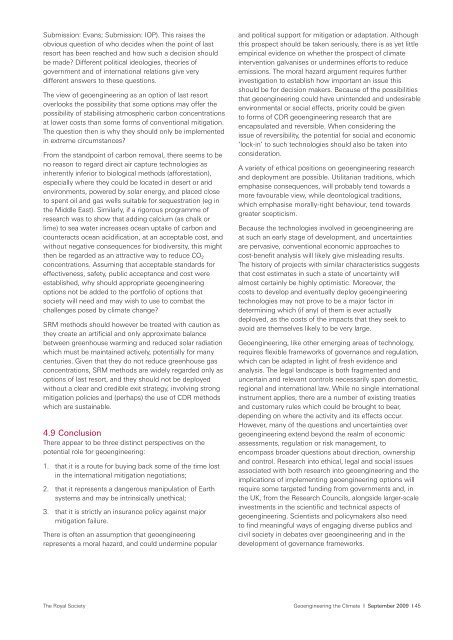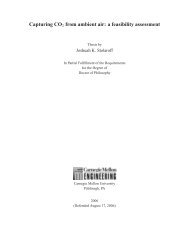Royal Society - David Keith
Royal Society - David Keith
Royal Society - David Keith
Create successful ePaper yourself
Turn your PDF publications into a flip-book with our unique Google optimized e-Paper software.
Submission: Evans; Submission: IOP). This raises the<br />
obvious question of who decides when the point of last<br />
resort has been reached and how such a decision should<br />
be made? Different political ideologies, theories of<br />
government and of international relations give very<br />
different answers to these questions.<br />
The view of geoengineering as an option of last resort<br />
overlooks the possibility that some options may offer the<br />
possibility of stabilising atmospheric carbon concentrations<br />
at lower costs than some forms of conventional mitigation.<br />
The question then is why they should only be implemented<br />
in extreme circumstances?<br />
From the standpoint of carbon removal, there seems to be<br />
no reason to regard direct air capture technologies as<br />
inherently inferior to biological methods (afforestation),<br />
especially where they could be located in desert or arid<br />
environments, powered by solar energy, and placed close<br />
to spent oil and gas wells suitable for sequestration (eg in<br />
the Middle East). Similarly, if a rigorous programme of<br />
research was to show that adding calcium (as chalk or<br />
lime) to sea water increases ocean uptake of carbon and<br />
counteracts ocean acidification, at an acceptable cost, and<br />
without negative consequences for biodiversity, this might<br />
then be regarded as an attractive way to reduce CO 2<br />
concentrations. Assuming that acceptable standards for<br />
effectiveness, safety, public acceptance and cost were<br />
established, why should appropriate geoengineering<br />
options not be added to the portfolio of options that<br />
society will need and may wish to use to combat the<br />
challenges posed by climate change?<br />
SRM methods should however be treated with caution as<br />
they create an artificial and only approximate balance<br />
between greenhouse warming and reduced solar radiation<br />
which must be maintained actively, potentially for many<br />
centuries. Given that they do not reduce greenhouse gas<br />
concentrations, SRM methods are widely regarded only as<br />
options of last resort, and they should not be deployed<br />
without a clear and credible exit strategy, involving strong<br />
mitigation policies and (perhaps) the use of CDR methods<br />
which are sustainable.<br />
4.9 Conclusion<br />
There appear to be three distinct perspectives on the<br />
potential role for geoengineering:<br />
1. that it is a route for buying back some of the time lost<br />
in the international mitigation negotiations;<br />
2. that it represents a dangerous manipulation of Earth<br />
systems and may be intrinsically unethical;<br />
3. that it is strictly an insurance policy against major<br />
mitigation failure.<br />
There is often an assumption that geoengineering<br />
represents a moral hazard, and could undermine popular<br />
and political support for mitigation or adaptation. Although<br />
this prospect should be taken seriously, there is as yet little<br />
empirical evidence on whether the prospect of climate<br />
intervention galvanises or undermines efforts to reduce<br />
emissions. The moral hazard argument requires further<br />
investigation to establish how important an issue this<br />
should be for decision makers. Because of the possibilities<br />
that geoengineering could have unintended and undesirable<br />
environmental or social effects, priority could be given<br />
to forms of CDR geoengineering research that are<br />
encapsulated and reversible. When considering the<br />
issue of reversibility, the potential for social and economic<br />
‘lock-in’ to such technologies should also be taken into<br />
consideration.<br />
A variety of ethical positions on geoengineering research<br />
and deployment are possible. Utilitarian traditions, which<br />
emphasise consequences, will probably tend towards a<br />
more favourable view, while deontological traditions,<br />
which emphasise morally-right behaviour, tend towards<br />
greater scepticism.<br />
Because the technologies involved in geoengineering are<br />
at such an early stage of development, and uncertainties<br />
are pervasive, conventional economic approaches to<br />
cost-benefit analysis will likely give misleading results.<br />
The history of projects with similar characteristics suggests<br />
that cost estimates in such a state of uncertainty will<br />
almost certainly be highly optimistic. Moreover, the<br />
costs to develop and eventually deploy geoengineering<br />
technologies may not prove to be a major factor in<br />
determining which (if any) of them is ever actually<br />
deployed, as the costs of the impacts that they seek to<br />
avoid are themselves likely to be very large.<br />
Geoengineering, like other emerging areas of technology,<br />
requires flexible frameworks of governance and regulation,<br />
which can be adapted in light of fresh evidence and<br />
analysis. The legal landscape is both fragmented and<br />
uncertain and relevant controls necessarily span domestic,<br />
regional and international law. While no single international<br />
instrument applies, there are a number of existing treaties<br />
and customary rules which could be brought to bear,<br />
depending on where the activity and its effects occur.<br />
However, many of the questions and uncertainties over<br />
geoengineering extend beyond the realm of economic<br />
assessments, regulation or risk management, to<br />
encompass broader questions about direction, ownership<br />
and control. Research into ethical, legal and social issues<br />
associated with both research into geoengineering and the<br />
implications of implementing geoengineering options will<br />
require some targeted funding from governments and, in<br />
the UK, from the Research Councils, alongside larger-scale<br />
investments in the scientific and technical aspects of<br />
geoengineering. Scientists and policymakers also need<br />
to find meaningful ways of engaging diverse publics and<br />
civil society in debates over geoengineering and in the<br />
development of governance frameworks.<br />
The <strong>Royal</strong> <strong>Society</strong><br />
Geoengineering the Climate I September 2009 I 45








